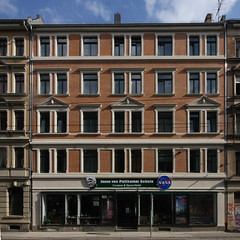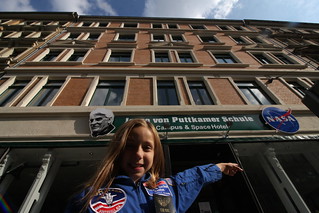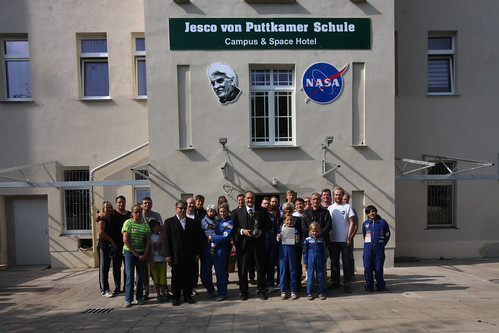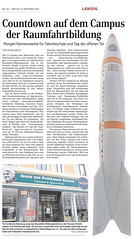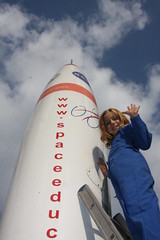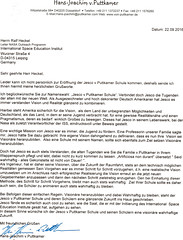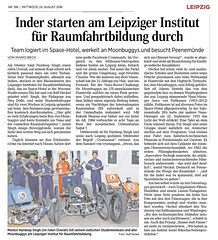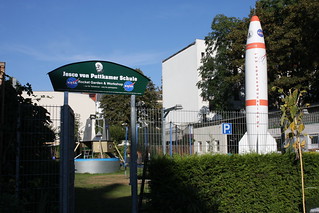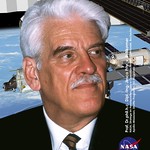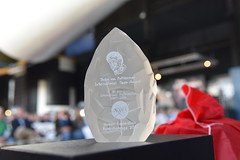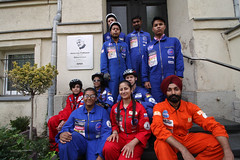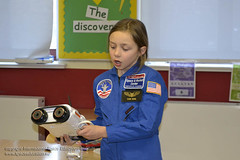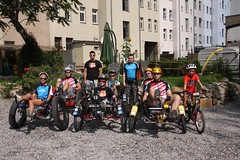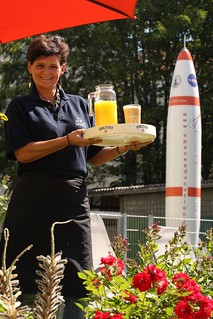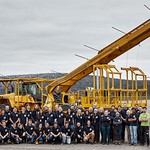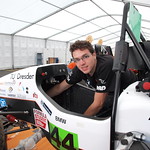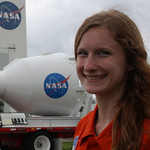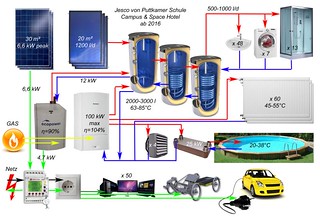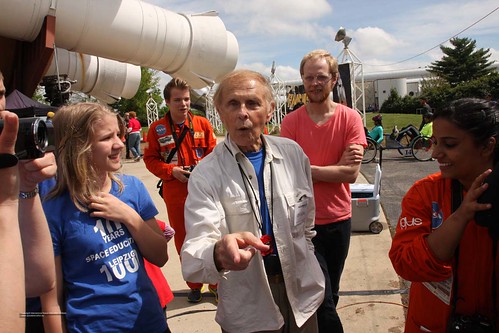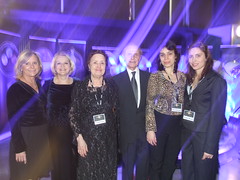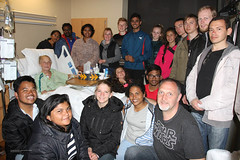| press news - News Presse Deutsch |
Award Zeremonie 2016
Zündung der Solar-Blockheizkraftanlage
Einweihung des Audimax auf unserem Campus
Mittwoch, 7.12.2016, 16-20 Uhr
Adresse: Jesco von Puttkamer Schule, Campus & Space Hotel
Wurzner Str. 4, 04315 Leipzig (Parkplatzschlüssel an der Rezeption)
Anmeldung: https://www.facebook.com/events/1700642433494051/
Nichtmitglieder zahlen eine Spende zwischen 20-50 Euro für eines der u.g. Nachwuchsprojekte und dessen Schüler. Schülerinnen und Schüler im Alter von 8-14 Jahren haben freien Eintritt.
Gastredner Sigmund Jähn
 Es war unsere 10. Teilnahme an der NASA-Roverchallenge 2017 und zugleich die 10. Internationale Teilnahme überhaupt. Die 4 Teams bestanden aus 50 Reisenden und kamen aus 6 Ländern – wieder ein neuer Rekord. Seit 2007 ermöglichten wir so 21 Teams und 171 Lernenden dieses Abenteuer für ihre berufliche Zukunft. Technische und finanzielle Herausforderungen wie Räder ohne Luftbereifung, Sensor-Datenübertragung, CAD-gestütztes Entwerfen und Herstellen, das Sammeln von nötigen Budgets und das Respektieren verschiedener Mentalitäten im multinationalen Team sind die Hard-Skills.
Es war unsere 10. Teilnahme an der NASA-Roverchallenge 2017 und zugleich die 10. Internationale Teilnahme überhaupt. Die 4 Teams bestanden aus 50 Reisenden und kamen aus 6 Ländern – wieder ein neuer Rekord. Seit 2007 ermöglichten wir so 21 Teams und 171 Lernenden dieses Abenteuer für ihre berufliche Zukunft. Technische und finanzielle Herausforderungen wie Räder ohne Luftbereifung, Sensor-Datenübertragung, CAD-gestütztes Entwerfen und Herstellen, das Sammeln von nötigen Budgets und das Respektieren verschiedener Mentalitäten im multinationalen Team sind die Hard-Skills.
Aber auch wir haben uns als Verein entwickelt. Wir sind Träger der „Jesco von Puttkamer Schule“ geworden, führen bis zu 1500 Interessenten aus 22 Ländern auf einem naturwissenschaftlichen Bildungsweg in die Zukunft und haben unseren Campus mit eigenen Mitteln in diesem Jahr ausbauen können. Es sind die Ideen, welche dies alles finanzieren – nicht die Fördermittel. So senkt die teils gespendete Solar-Blockheizkraftanlage die stets steigenden Energiekosten, zahlen bis zu 7000 Leipzig-Touristen jährlich unsere Bildungsarbeit und bis zu 100 beherzte Unternehmen liefern gern Material und kleine Dienstleistungen.
Unser Gründer gab „Grasroots“ vor und wir haben diesen Weg gründlich verfolgt. Sie alle haben sich damit ein fortwährendes Denkmal gesetzt. Man kann sich damit zeigen, gern auch an unserer neuen „Wall of Honor“, ab 2017.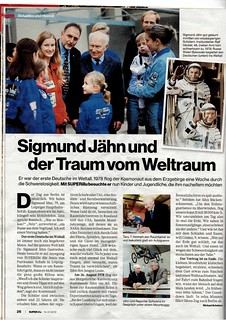 Es ist nun an der Zeit sich die Ergebnisse mal anzusehen. Wir möchten den Audimax unseres polytechnischen Zentrums einweihen, die Solar-Blockheizkraftanlage starten und sehen was aus den verschiedenen Schüler-Generationen der letzten knapp 12 Jahre seit unserer Gründung auf dem Hinterhof geworden ist. Sie werden erstaunt sein.
Es ist nun an der Zeit sich die Ergebnisse mal anzusehen. Wir möchten den Audimax unseres polytechnischen Zentrums einweihen, die Solar-Blockheizkraftanlage starten und sehen was aus den verschiedenen Schüler-Generationen der letzten knapp 12 Jahre seit unserer Gründung auf dem Hinterhof geworden ist. Sie werden erstaunt sein.
Programm am 7. Dezember 2016
16:00h Sektempfang, Gespräche, Bufett, Rundgang
17:00h Zündung der Solar-Blockheizkraftanlage
17:30h Einweihung des Audimax auf unserem Campus
mit Ausstellung von Schüler-Exponaten
Zukunft durch Engagement: Yvonne und Ralf Heckel, Gründer/Vorstand
von der Hinterhof-Garage zum Silicon Valley in Leipzig, Stand der Umbauarbeiten, die Jesco von Puttkamer Schule, das neue Polytechnische Zentrum, das Space Hotel, das hauseigenes Kraftwerk, Nutzungskonzept und Zahlen, (15-20 min)
LED-Weichnachtsbaum mit Steuerung: Tara Heckel (7)
Telemetrie Team: Cosma Heckel (9), Firine (12), Lucas Wittersheim (14), Videotelemetrie und Datenübertragung für ein Marsmobil (My Robot, Arduino) (5-10 min)
NASA Rover Team 2016: Nadin Rößler (23), Tobias Meier (20), mit 50 Teilnehmern aus 6 Ländern und 4 Teams zum Wettbewerb, Herausforderungen, Ergebnisse, Lehren, (15-20 min)
NASA Rover Team 2017: Johnas Stiemer (17), Elektromobilität mit den NASA-Rovern als Abitur-Prüfungsprojekt, (5-10 min)
Diane-Projekt: Dipl.-Ing. Evgeniy Zakutin (27), Nadin Rößler (23), aufblasbarer Dipol auf Raketenträger für künftige Satelliten (ESA-Projekt), (15-20 min)
19:00h Gastredner Sigmund Jähn
erster deutscher Raumfahrer, der Mensch im All, technische und zwischenmenschliche Herausforderungen, Tipps an die junge Generation
There are no translations available. (Leipzig) Am Samstag dem 24.09.2016 wurde in Leipzig feierlich die Jesco von Puttkamer Schule eröffnet. Neben Gästen, Förderern und interessierten jungen Naturforschern trafen vor allem Grußnoten aus der ganzen Welt ein. Eines der wohl wichtigsten Schreiben war vom 2. Vorsitzenden des Vereins des Geschlechtes der Familie von Puttkamer. Darin schrieb Herr Hans-Joachim von Puttkamer (ein Großneffe von Prof. Dr. Jesco von Puttkamer): " "Artificiosa non durant" übersetzt " Seid wahrhaftig - alles Gekünstelte ist nicht von Dauer ! ... Bei Befolgen dieser einfachen Regeln, Visionäre heranzubilden und dabei Wahrhaftig zu bleiben, steht der Jesco v.Puttkamer Schule und deren Schülern eine glänzende Zukunft ins Haus geschrieben. ... Eine wichtige Mission von Jesco war es immer, die Jugend zu fördern. Eine Professorin unserer Familie sagte mir, Jesco hätte Sie dazu gebracht Ihre eigene Vision dahingehend zu definieren, dass es nun Ihre Vision sei Visionäre heranzubilden. Also eine Schule mit seinem Namen, sollte sich ebenfalls zum Ziel setzen Visionäre heranzubilden." Emails trafen aus Washington DC, Huntsville und Moskau ein. So schrieb der 3-fache Space Shuttle Astronaut und Leiter der bemannten Raumfahrt der NASA bis 2006, heute Industrieberater, William Readdy: "Best wishes as you celebrate JvP's legacy with the next generation of space explorers on his special day!" Tom White, US-Space Camp in Huntsville, schrieb: "Congratulations to you and your team!" Aber auch Partner aus Leipzig zögerten nicht mit Geschenken, Blumensträußen und Grußnoten. So erschien Herr Ronny Hessel, Meister und Inhaber der CNC-Dreherei Günther Jakob mit Grußworten und einem Präsent. Die Tauchlehrer-Familie Florian schrieb: "Ihr seid eine tolle Familie und habt sehr viel erreicht. Herzlichen Glückwunsch!!!" Fotogallerie: https://www.flickr.com/photos/spaceeducation/albums/72157673165312022 Nach der Verlesung des Briefes und einigen Erklärungen zum Umbau mit einem Budget von 300.000 Euro und den neuen Aufgaben servierte der benachbarte Catering Service leckere Pilzpfanne und Mutzbraten mit Salaten. Es fanden viele Gespräche statt.
Roboter AG wird präsentiert von Sotiris Mitsopoulos (11), Cosma (9) und Tara Heckel (7), Lego-Level in 3 Stufen NASA-Rover AG Elektro-Rover als BeLL-Arbeit Mitgliedschaften und Teilnahmen Berufsorientierung Ingenieur und CAD/CAM
Opening of the first "Jesco von Puttkamer School" Those looking for a science group, those interested in assistance with the Bell-Arbeit for the Abitur, or those looking to participate in an exchange program to Germany can apply for the academic year at this occasion. Prof. Dr. Jesco von Puttkamer The founders oft he first Jesco von Puttkamer school in Leipzig have personally been guided by Jesco since 2003. The international team award named after him is awarded to the fastest international team at the NASA Rover Challenge every year (and has been awarded to the Leipziger based teams 6 times). Von Puttkamer believed that a school should supporting students in their scientific pursuits. The Renovation After School Activities The Campus The Mainbuilding The Space Hotel is popular with tourists and conference visitors coming to Leipzig, during the times when no workshops or seminars are held, as it offers inexpensive and clean accomodation witch can be easily booked online. The earnings are used to support the non-profit services of the school. This way, the Space Hotel has become the most booked hotel of economy class in Leipzig. It is also a popular place for visitors of Leipzig, promoters and international guests. Quite regular VIPs from industry, politics and science can be welcome as guests. Among them have already been Prof. Dr. von Puttkamer, the family of the Sputnik designer Sergey P. Korolev, astronauts, cosmonauts and a Prime Minister. The Workshop Available is a complete machine-tool arsenal, a gas welding machine, column drill, grinders, soldering station, awood workshop, and ametal workshop. CNC machines will soon be also available. The Rocket Garden The Parking Lot The Student Living Area
This year's CAD-CAM projects:
We are also supporting two students for a carrier at NASA in Huntsville, AL, USA. We also express are thanks and gratitude to the following businesses and individuals for the support and assistance during the restoration of the campus 2016: Doerffer Sandstrahltechnik GmbH, Leipzig renovation projekt:
Life on the ISS depends on their energy budget. In addition to small quantities of fuel being transported consuming, primarily supplies the sun all life support systems and aggregates. The International Space Education Institute modified its power supply with the Jesco von Puttkamer school, the workshops and the Habitat (Space Hotel) on sun. So the young scientists get an idea of ??sustainable energy use. Since this week the solar power plant was installed on the roof. It is divided into 3 components: - 30 m² photovoltaic (6.6 kilowatts) Thus, in future, the amount of energy used is produced to operate the "Jesco von Puttkamer school" and their departments themselves. Excess electrical power is fed into the network. Electricity consumption during the night will largely be refinanced. On very sunny days, excess heat from the solar thermal energy has to be dissipated. This is fed to a 2000 liter / 530 gal hot water tank for showering and washing. In the transitional seasons even bleigt left some heat for a basic supply of heating the rooms. Excess heat is dissipated in the summer to heat the outdoor pool (38°C / 100°F temperature in the pool are possible). On cloudy days and in snow adds a mini-cogeneration plant from "Ecopower" the energy-budget in the basement. This consists of a single-cylinder 4-stroke engine and is driven by natural gas. A generator replaces the complete power of the photovoltaic to 5 kW. In addition, it produces a fundamental requirement of 12 kW hot water to recharge the hot water tank and basic operation of the heater. So this powerstation adds 120 kWh electricity and 288 kWh for wamwater per day! The heating of all buildings on campus takes in the winter months, a natural-gas powered energy-efficiency heating of "Junkers" with a peak power of 100 kW. This benefit is especially important for the heating of the workshops on the Campus. An own subterranean district heating pipe ensures the transport of energy. So the steady weekly technical after-school-activities with students are now also possible in the cold months. Carger for the selfmade NASA-E-Rover and pugs for E-Cars on the Campus´ parking lot are in preperation. The win with this intelligent system saves circa 400-800 euros (US$ 450-900) / month are used to promote the youth work of the institute and its young scientists. An online monitor published in the house and on the website the result of this captive power plant. So the young scientists who are learning here, their sponsors and the Space-hotel guests are able to see the energy balance of this house. If necessary they can adapt their life and work to the rhythm of the sun and its environment. Similarly the astronauts and cosmonauts living aboard the ISS, are doing the same. The namesake of this school "Prof. Jesco von Puttkamer" was the 1st ISS-director for 14 years long. So this technology is honoring his work and life for young scientists Thanks to Aizhigit Tabanov (Young Engineer for Aerospace, Bishkek, Kyrgyzstan) for his cooperation in the realization of the project: (https://www.facebook.com/groups/NASA.summercamp/?fref=ts) Thanks to Dr. Loeser from the company Dr. SOL Solarsystems in Leipzig (http://www.drsol.de). more photos:
There are no translations available.
My collegue and judge Tom Hancock (AIAA) said to me at the NASA Roverchallenge: "Ralf, Al want to see you with your international students in the Hospital". So it was a pleashure for me to come with all 17 students what we had with us. They came from Bolivia, India, Russia and Germany. Al told them a long story about his life, his fight for the future and our responsibility to push their work - together with all visioneers of this world. In this small room was an increddible silence. Everybody was able to crab each of his words and record it into his mind.
Now, Al passed away in summer 2016, July 24th. So a lot of high experienced people went from us, whitnesses from the pioneers time of spaceflight. It is a big loss. We are sad about his death. But we also are knowing that his conversations will still live in our mind and will guide us into the next future of our exploration. Follow the tracks of the forefathers, with their strong rules and core values. Turn around the comfort zone, change the sofa with your shoes and build bridges instead of walls. The view back from space what Al also made with Apollo 8 - teaches us that we are: one world, one menkind and one community. Al, you was a fighter to reach the stars. Now you are there. Be shure that the international young generation is wishing you a safe flight! Ralf Heckel, |































